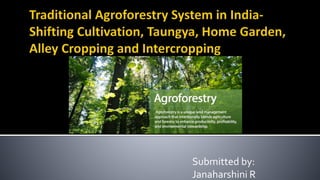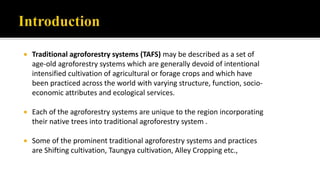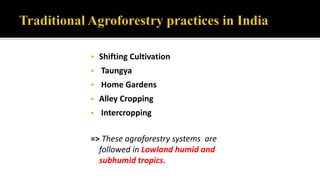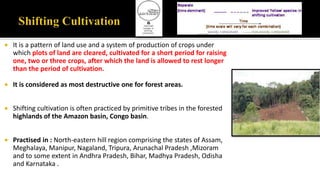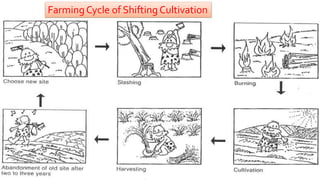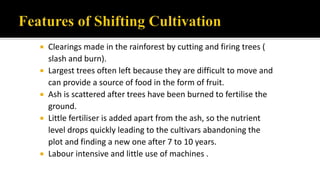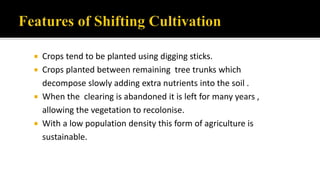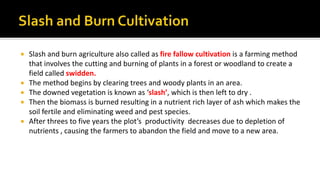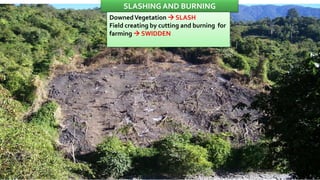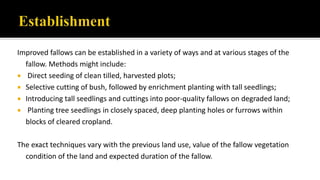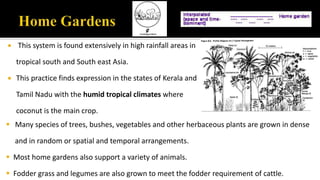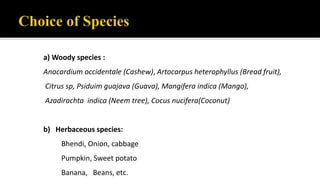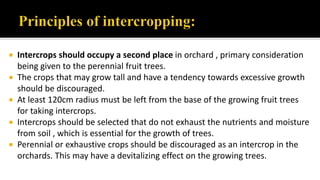Traditional Agroforestry System in India- Shifting Cultivation, Taungya, Home Garden, Alley Cropping and Intercropping.pptx
- 2. Traditional agroforestry systems (TAFS) may be described as a set of age-old agroforestry systems which are generally devoid of intentional intensified cultivation of agricultural or forage crops and which have been practiced across the world with varying structure, function, socio- economic attributes and ecological services. Each of the agroforestry systems are unique to the region incorporating their native trees into traditional agroforestry system . Some of the prominent traditional agroforestry systems and practices are Shifting cultivation, Taungya cultivation, Alley Cropping etc.,
- 3. Shifting Cultivation Taungya Home Gardens Alley Cropping Intercropping => These agroforestry systems are followed in Lowland humid and subhumid tropics.
- 5. It is a pattern of land use and a system of production of crops under which plots of land are cleared, cultivated for a short period for raising one, two or three crops, after which the land is allowed to rest longer than the period of cultivation. It is considered as most destructive one for forest areas. Shifting cultivation is often practiced by primitive tribes in the forested highlands of the Amazon basin, Congo basin. Practised in : North-eastern hill region comprising the states of Assam, Meghalaya, Manipur, Nagaland, Tripura, Arunachal Pradesh ,Mizoram and to some extent in Andhra Pradesh, Bihar, Madhya Pradesh, Odisha and Karnataka .
- 6. Amazon Basin
- 7. Slash and burn cultivation Jhum – in North –Eastern hill region Dahiya or Bewar – in Madhya Pradesh Penda or Podu – in Andhra Pradesh Khallu / Kurwa - in Jharkhand Khil – in Himalayan belt Pamlou- in Manipur Kumari – in Western Ghats Pama Dabi or Koman – in Odisha Taungya – in Burma Chena – in Sri Lanka
- 8. Farming Cycle of Shifting Cultivation
- 9. Clearings made in the rainforest by cutting and firing trees ( slash and burn). Largest trees often left because they are difficult to move and can provide a source of food in the form of fruit. Ash is scattered after trees have been burned to fertilise the ground. Little fertiliser is added apart from the ash, so the nutrient level drops quickly leading to the cultivars abandoning the plot and finding a new one after 7 to 10 years. Labour intensive and little use of machines .
- 10. Crops tend to be planted using digging sticks. Crops planted between remaining tree trunks which decompose slowly adding extra nutrients into the soil . When the clearing is abandoned it is left for many years , allowing the vegetation to recolonise. With a low population density this form of agriculture is sustainable.
- 12. Slash and Burn • Slash and Burn (another name of shifting cultivation) is mostly practiced in Central America, Madagascar, Africa, India, Papua, New Guinea, etc.
- 13. Slash and burn agriculture also called as fire fallow cultivation is a farming method that involves the cutting and burning of plants in a forest or woodland to create a field called swidden. The method begins by clearing trees and woody plants in an area. The downed vegetation is known as ‘slash’, which is then left to dry . Then the biomass is burned resulting in a nutrient rich layer of ash which makes the soil fertile and eliminating weed and pest species. After threes to five years the plot’s productivity decreases due to depletion of nutrients , causing the farmers to abandon the field and move to a new area.
- 14. SLASHING AND BURNING DownedVegetation SLASH Field creating by cutting and burning for farming SWIDDEN
- 15. Fallows are crop land left without crops for periods ranging from one season to several years. The OBJECTIVE of improved fallow species in shifting cultivation is to recover depleted soil nutrients and reduce soil erosion. Once the soil has recovered, crops are reintroduced for one or more season. The BEST SPECIES for the fallow system should induce good nitrogen fixation in the soil. Plants included in improved fallows should be compatible with future crops, free of any negative physical or chemical effects on the soil and not in competition with the crops to be planted later on the same site.
- 16. Fallow period and Crop yield & soil productivity in shifting cultivation The cultivation phase is usually short (2-3 years), but the regeneration phase, known as the fallow or bush fallow phase, is much longer (traditionally 10-20 years).The length of the fallow phase is considered critical to the success and sustainability of the practice.
- 17. Useful trees and shrubs are left standing and are sometimes lightly pruned ; other trees and shrubs are pruned down to stumps of varying height to facilitate fast regeneration support for climbing species that require staking. The length of the cropping and fallow phases vary considerably , the former being more variable. Usually the fallow phase is several times longer than the cropping phase. During this period the soil, having been depleted of its fertility during the cropping period , regains its fertility through the regenerative action of woody vegetation.
- 19. Improved fallows can be established in a variety of ways and at various stages of the fallow. Methods might include: Direct seeding of clean tilled, harvested plots; Selective cutting of bush, followed by enrichment planting with tall seedlings; Introducing tall seedlings and cuttings into poor-quality fallows on degraded land; Planting tree seedlings in closely spaced, deep planting holes or furrows within blocks of cleared cropland. The exact techniques vary with the previous land use, value of the fallow vegetation condition of the land and expected duration of the fallow.
- 20. Species choice should be exclusively confined to ‘ soil improvers’ ; plants with marketable products should also be considered. Plants included in improved fallows should be compatible with future crops, free of any negative physical or chemical effects on the soil and not in competition with the crops to be planted later on the same site.
- 21. Small investment needed. Simple growing method. No need of animal labour power. Environmentally friendly because its organic form. It may reduce the incidence of soil borne diseases. It can play a part in pest management.
- 22. Deforestation Destroying the habitats of wild animals Soil erosion which leads to soil and nutrient losses, silting of reservoirs and streams, landslips and landslides. Ecology is disturbed and distorted which never restored. Shifting cultivation adversely affects cation exchange capacity and physical properties of soil. It leads to lowering of organic matter and lowering the total quantity of sesquioxides, iron, aluminum, calcium, potassium, phosphorus, etc. Increases soil pH and reducing microbial activity More weed growth and lower crop yield No opportunity for infrastructural development
- 23. Motivate public for permanent agriculture by opening demonstration center's for improved agricultural practices , good quality seed , manuring , irrigation , weeding . Engaging local people in forest work and training them to undertake shifting cultivation on scientific basis. Arable lands can be given to tribal’s for carrying out agriculture and also to settle in the area , a few schemes are being implemented under integrated tribal development schemes Legal measures on steep slopes , near to roadsides . Development of animal husbandry and dairy farming. Using land according to its capability. Employment in forest works and other industries.
- 24. It is a faulty land use which enhances soil degradation by way of soil erosion. It is a primitive method of cultivation in which crop yields are less and requires hardwork. Due to complete cutting and burning of vegetation there is an abrupt changes in soil microbial population. There is loss nutrients from the soil through run off, leaching and percolation. The carbon, nitrogen ratio reduces due shifting cultivation. The excessive run-off in the shifting cultivated areas causes floods in the adjoining plains. Denudation of hill slopes takes place. Wildlife in the shifting cultivated areas is badly affected. It disturbs the fauna. Forest flora become weak and grow sparsely.
- 25. Taung – Hill + Ya – Cultivation = Taungya Modified form of Shifting cultivation Burmese Word coined in Burma (1850’s) Introduced in India by D.Brandis in 1890 First taungya Plantation was in 1896 at Bengal South –Kumari Practised in 1200 – 1500 mm rainfall areas Practised in: Kerala , West Bengal , UP and to a lesser extent in Tamil nadu, AP and Orissa
- 26. Crops are allowed to raise in the interspaces of the tree species. Cultivators are responsible for the upkeep of the plantation. The practice consists of land preparation, tree planting, growing agricultural crops for 1-3 years, until shade becomes too dense, and then moving on to repeat the cycle in a different area. In some cases, crops may be grown one year before the trees are planted. This system was introduced to raise forest plantation but finally became a recognized agroforestry system.
- 27. a) Departmental Taungya Under this, agricultural crops and Plantation are raised by the forest department by employing a number of labourers on daily wages. The MAIN AIM of raising crops along with the plantation is to keep down weed growth.
- 28. (b)Leased Taungya The plantation land is given on lease to the person who offers the high money for raising crops for a specified number of years and ensures care of tree plantation.
- 29. (c) Village Taungya This is the most successful of the three taungya systems. In this crops are raised by the people who have settled down in a village inside the forest for this purpose. Usually each family has about 0.8 to 1.7 ha of land to raise trees and cultivate crops for 3 to 4 years.
- 30. The Taungya is considered as another step in the process of transformation from shifting cultivation to agroforestry. Shifting system is sequential system of growing woody species and agricultural crops. Taungya consist of the simultaneous combination of the two components during the early stages of forest plantation establishment. OBJECTIVE- Wood production in the Taungya system while food production in shifting cultivation. In shifting cultivation the length of the agricultural cycle can last only as long as the soil sustains the reasonable crop yields. In Taungya , it is primarily dependent on the physical availability of space and light based on the planting arrangement of the trees.
- 31. A)TREES Tectona grandis Bamboo Santalum album Tamarindus indica Acacia nilotica (Babul tree) Acacia mearnsii (Black Wattle tree) Ceiba pentandra (Kapok tree -Illava maram) Cashew, Rubber B) CROPS Millet, pulses, groundnut,cotton
- 32. State Tree crop Associated agricultural crops UP Sal tree , teak , Black cutch(Cenkarungali) , Indian rosewood, Eucalyptus species Maize , paddy , sorghum , pigeon pea , soyabean , wheat , barley , chick pea Andhra Pradesh Cashew tree, Teak , silk cotton tree , Bamboo , Eucalyptus species Hill paddy , groundnut, sweet potato Kerala Teak , silk cotton tree , Eucalyptus species Paddy , tapioca ,ginger, turmeric Tamil nadu Teak , Indian sandalwood, tamarind , Gum Arabic tree , black wattle tree , cashew , rubber , mango , Kapok tree Millet ,pulses , groundnut , cotton Maharashtra Teak , Gum Arabic tree Sunhemp , jute ,sunflower , castor Karnataka Teak , Indian sandalwood tree Paddy , tapioca West Bengal Teak , Sal tree , needle wood tree, Japanese cedar Paddy , maize , millets ,turmeric , ginger , lady’s finger , pineapple
- 33. Artificial regeneration of the forest is obtained cheaply Problems of unemployment are solved Helps towards maximum utilization of the site Low cost method of forest plantation establishment Highly remunerative to forest departments Provision of food crops from forest land Weed, climber growth etc. is eliminated
- 34. Loss of soil fertility and exposure of soil Danger of epidemics Legal problems created Susceptibility of land to accelerated erosion increases There is an exploitation of human labour
- 35. Free grazing for animals Free timber for house construction and manufacturing agricultural Implements Schooling facilities for children Monitory loan at nominal interest Water supply by excavation of wells and construction of ponds.
- 36. This system is found extensively in high rainfall areas in tropical south and South east Asia. This practice finds expression in the states of Kerala and Tamil Nadu with the humid tropical climates where coconut is the main crop. Many species of trees, bushes, vegetables and other herbaceous plants are grown in dense and in random or spatial and temporal arrangements. Most home gardens also support a variety of animals. Fodder grass and legumes are also grown to meet the fodder requirement of cattle.
- 37. They are small –more or less around 0.5 ha . The other main characteristic of the home garden is their high productivity rates and diversity of the production to satisfy the primary needs of the farmer, like food fuel, timber and cash. The whole tree-crop-animal units are being intensively managed by family labour . Home gardens are also called as Multitier system or Multitier cropping. They are highly productive, sustainable and very practicable. Food production is the primary function of most home gardens.
- 38. It is characterized by high species diversity and usually 3-4 vertical canopy strata. Herbaceous layer near the ground Tree layer at the upper levels and Intermediate layer
- 39. The lower layer partitioned in to two, the lowermost being at less than 1.0m in height, dominated by different vegetables and the second layer of 1.0 -3.0m height comprising food crops such as banana, papaya and so on. The upper tree layer can also be divided into two, consisting of emergent, full grown timber and fruit crops occupying the uppermost layer of 25m in height and medium sized trees of 10-20 m occupying the next lower layer. The intermediate layer of 5-10 m height is dominated by various fruit trees.
- 41. a) Woody species : Anacardium occidentale (Cashew), Artocarpus heterophyllus (Bread fruit), Citrus sp, Psiduim guajava (Guava), Mangifera indica (Mango), Azadirachta indica (Neem tree), Cocus nucifera(Coconut) b) Herbaceous species: Bhendi, Onion, cabbage Pumpkin, Sweet potato Banana, Beans, etc.
- 42. Alley cropping is planting rows of trees at wide spacing with a companion crop grown in the alleyways between the rows. Alley cropping can diversify farm income, improve crop production and provide protection and conservation benefits to crops. Common example – wheat , corn , soyabeans or hay planted in between rows of black walnut or pecan trees. Value added crops may also be incorporated for extra income , including sunflower or medicinal herbs planted in between rows of nut trees alternated with nursery stock trees.
- 44. Positioned in an east-west direction Plants on both sides receive full sunlight Spacing - 4 to 8 metres between rows 25 cm to 2 metres between trees within rows Closer spacing - humid areas Wider spacing - subhumid or semi-arid regions On sloping land - always be placed on contour
- 45. Alley cropping usually includes leguminous trees to improve soil fertility through nitrogen fixation. The trees used in alley cropping should form a deep taproot system with few lateral root branches near the surface so as not to compete with crop roots. The trees / shrubs used should fix nitrogen and should also produce wood, fodder , food, medicine for the usage to farming community. The species selected should grow well under the specific limitations of the site such as saline or acidic soils , drought , flooding , heavy winds , resistant to pest or other hazards. It should have a sparse , small crown to permit sunlight penetration . Cassia siamea , Leucaena leucocephala(Subabul), Gliricidia sepium, Calliandra calothyrsus, Sesbania sesban are commonly used tree species for alley cropping.
- 47. Improved crop performance due to the addition of nutrients and organic matter into the soil/plant system. Reduction of the use of chemical fertilisers. Improvement in the physical nature of the soil environment. Reductions in erosion losses. Provision of additional products such as forage, firewood or stakes when a multipurpose tree legume is used as the hedgerow, and Improvement in weed control.
- 48. Alley cropping provides the opportunity to grow wood or other tree products such as nuts or fruit , while providing an annual income through the production of companion crops. Alley cropping diversifies farm enterprises by providing short term cash flow from annual crops while also providing medium to long term products from the woody components. Alley cropping protects fragile soils through a network of roots produced by the trees and supplemental ground cover resulting from fallen leaves and the companion crop.
- 49. Alley cropping reduces damage from insect pest by reducing crop visibility , interfering with pest movement and creating habitat more favorable to beneficial insects. It can reduce crop evapotranspiration by 15-30 % and increase water content in the tillage layer by 5-15%. Linear plantings of trees or shrubs in an agricultural landscape increases the habitat diversity for wildlife.
- 50. Requires a more intensive management system including specialized equipment for the tree management and additional managerial skills and training to manage multiple crops on a given site. Trees may be an obstacle to crop cultivation if not carefully planned and designed. Trees compete with companion crops for sun, moisture and nutrients. Herbicide drift from crops may damage trees.
- 51. Spatial arrangement of crops. The annual and Perennial crop components are simultaneously present on site but are spaced in such a manner that they became mutually supportive rather than competing. Under such circumstances, they may jointly yield higher outputs per hectare per year.
- 52. Border tree planting Alternate rows Alternate strips Random mix
- 53. Lines of trees specifically a boundary markers, live fences, wind breaks or fire breaks. Protecting or stabilizing the site Producing green manure as organic fertilizer and producing fuel wood.
- 54. Alley , Avenue, Corridor , Zonal or Hedgerow cropping Found most effective for erosion control and slope stabilization.
- 55. A Strip differs from a row in that it is composed of two or more rows
- 56. Displays no specific or orderly placement of the component crops. The Plants actually occupy their own special ecological niches and are able to coexist very well.
- 57. Intercrops should occupy a second place in orchard , primary consideration being given to the perennial fruit trees. The crops that may grow tall and have a tendency towards excessive growth should be discouraged. At least 120cm radius must be left from the base of the growing fruit trees for taking intercrops. Intercrops should be selected that do not exhaust the nutrients and moisture from soil , which is essential for the growth of trees. Perennial or exhaustive crops should be discouraged as an intercrop in the orchards. This may have a devitalizing effect on the growing trees.
- 58. Yield decreases as the crops differ in their competitive abilities. Management of intercultural crops having different cultural practices seems to be difficult task. Harvesting is difficult Higher amount of fertilizer or irrigation water cannot be utilized properly as the component crops vary in their response of these resources.
